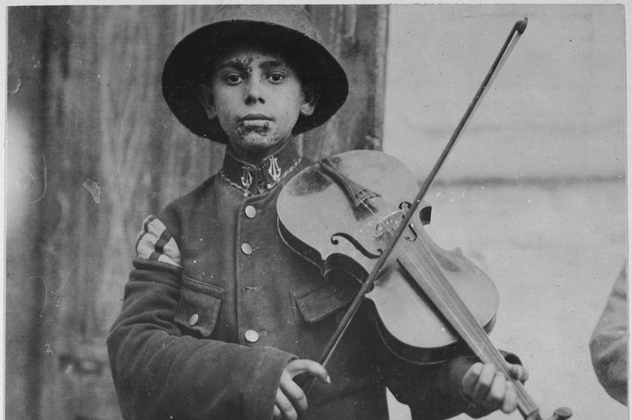 History
History  History
History  Music
Music 10 Surprising Origin Stories of Your Favorite Holiday Songs
 History
History 10 Less Than Jolly Events That Occurred on December 25
 Weird Stuff
Weird Stuff 10 Funny Ways That Researchers Overthink Christmas
 Politics
Politics 10 Political Scandals That Sent Crowds Into the Streets
 Weird Stuff
Weird Stuff Ten Bizarre Facts About The Doge Meme
 Our World
Our World 10 Ways Your Christmas Tree Is More Lit Than You Think
 Movies and TV
Movies and TV The 10 Coolest Stars to Set Sail on The Love Boat
 History
History 10 Things You Didn’t Know About the American National Anthem
 Technology
Technology Top 10 Everyday Tech Buzzwords That Hide a Darker Past
 History
History 10 Huge Historical Events That Happened on Christmas Eve
 Music
Music 10 Surprising Origin Stories of Your Favorite Holiday Songs
 History
History 10 Less Than Jolly Events That Occurred on December 25
Who's Behind Listverse?

Jamie Frater
Head Editor
Jamie founded Listverse due to an insatiable desire to share fascinating, obscure, and bizarre facts. He has been a guest speaker on numerous national radio and television stations and is a five time published author.
More About Us Weird Stuff
Weird Stuff 10 Funny Ways That Researchers Overthink Christmas
 Politics
Politics 10 Political Scandals That Sent Crowds Into the Streets
 Weird Stuff
Weird Stuff Ten Bizarre Facts About The Doge Meme
 Our World
Our World 10 Ways Your Christmas Tree Is More Lit Than You Think
 Movies and TV
Movies and TV The 10 Coolest Stars to Set Sail on The Love Boat
 History
History 10 Things You Didn’t Know About the American National Anthem
 Technology
Technology Top 10 Everyday Tech Buzzwords That Hide a Darker Past
10 Historically Villainous Groups Who Were Also Victims
We like to think we know who the “bad guys” are in history, and often we’re right. You’d be hard pressed, for example, to find anyone who thinks Pol Pot’s Khmer Rouge were anything but monsters. But other times our snap judgment is a little off. Every now and then, groups of people wind up going down in history as evil, despite suffering unimaginable tragedies of their own. And while plenty of them may still have committed despicable acts, some are also victims who simply wound up on the wrong side of history.
10 The Yugoslav Serbs

The Balkan Wars are two of the messiest conflicts in European history. As the former Yugoslavia disintegrated, Serb armies laid siege to the city of Sarajevo and undertook ethnic cleansing operations in Kosovo and Srebrenica that left tens of thousands dead. Bosnian-Muslims, Albanians, and Croats were all massacred at the hands of genocidal Serbian forces. In no other modern conflict has the division between good and evil been so starkly apparent.
At least that’s the popular version. Look a little closer and disturbing shades of gray start to emerge—such as the crimes committed against Serbs by Croatian and Albanian forces. In 1991, Croat officials announced on radio that the war-torn town of Gospic was now safe for ethnic Serbs who had fled when the fighting started. As the Serbs slowly trickled back in, the local chief of police made a list of the names and homes of the returning civilians. A few days later, this “death list” was used to round up 120 of them in cattle trucks. Their bodies were later found in mass graves. Only one man was ever convicted for the massacre.
Elsewhere in the collapsing Yugoslavia, a Croat death squad allegedly detained, tortured, and executed 43 Serb-Croats. In Kosovo, Albanian paramilitaries responded to Serbian atrocities by allegedly kidnapping Serbs and their collaborators and harvesting them for their organs.
Undoubtedly Serb forces did some terrible, unforgivable things. But the actions of a government—no matter how evil—should never be used to justify the wholesale murder of innocent civilians.
9 IRA Supporters

Until recently, the IRA was one of the nastiest terrorist organizations in the world. Over the course of several years, they carried out assassinations and bombings that left dozens dead and hundreds wounded. In one gruesome case they kidnapped a man’s family and forced him to carry out a suicide bombing in return for his children’s lives. In short, they’ve done some truly despicable things. But that doesn’t excuse the treatment handed out to their supporters by the British.
In 1971, British forces swooped on Northern Ireland and rounded up 342 suspected members. Some of them were simply Catholics they’d misidentified. Others were the real deal. All of them were interred in a prison camp without trial and with no release date, at which point the torture started.
After being beaten half to death, inmates had a hood shoved over their heads before being made to stand spread-eagle against a wall. There they were bombarded with loud, disorientating white noise scientifically designed to induce psychosis. Sleep was forbidden. Food and water were nowhere to be seen. Any movement from the spread-eagle position—even fainting—resulted in a ferocious beating. Inmates were kept like that for up to six days at a time. Meanwhile, more suspected members were being brought in. According to the BBC, 1,900 people would eventually pass through the camp in a dark chapter now almost scrubbed out of history.
8 The Sandinistas

In 1979, Nicaragua’s popular Sandinista movement propelled Daniel Ortega into power, ushering in over a decade of oppression, forced disappearances, and random executions. Today, Ortega is seen as a semi-dictator and his Sandinistas are viewed as naïve at best, and dangerous lunatics at worst. Yet while this might be a fair description of these Marxist revolutionaries, it’s only half of the story.
The other half involves a family known as the Somozas. In 1979, they owned over 50 percent of Nicaragua’s land and exactly 100 percent of its political system. Their dictatorship was almost unbelievable in its brutality. When rumblings of revolution began in Nicaraguan neighborhoods, these proto-Sopranos sent in jets to bomb civilians, killing tens of thousands. Their torture centers were infamous, and thousands of those who later became Sandinistas passed through their halls, including Ortega himself. When the Somoza family was finally kicked out by the rebels, they cultivated a private army (with US backing) that went on to indiscriminately butcher civilians involved with the Sandinista movement.
It’s right that we remember the awful abuses of Ortega’s 11-year reign. But this is definitely one of those cases where both sides were as bad as each other.
7 The Muslim Brotherhood

The Muslim Brotherhood is a hardcore Islamic party who took control of post-revolution Egypt, ushering in a year of human rights abuses and strict clampdowns on religious freedom. So when the military deposed their leader in a coup last July, our media gave a collective cheer and assured us the “bad guys” had been defeated.
Or had they? Take a close look at the evidence piling up from organizations such as Amnesty and Human Rights Watch, and the true position of the Brotherhood quickly becomes apparent. Since July, a minimum of 1,400 of their members have been killed by security forces. A month after the coup, the Egyptian army opened fire on a group of their protestors, killing 120 and injuring 4,500. In mid-August, a sit-in was cleared with machine guns, sniper rifles, and bulldozers, killing hundreds of people. Kids as young as 17 were shot through the head. At least one protestor was burned alive. Military snipers even trained their fire on a nearby hospital entrance and killed anyone seeking help.
Currently, supporters of the Brotherhood live in daily fear of forced disappearance, torture, and murder. They’ve been branded “terrorists” and lost all rights as Egyptian citizens and human beings. Sure, their time in power may have been awful for ordinary Egyptians, but that shouldn’t hand the military a blank check to exterminate them.
6 The FARC

Colombia’s FARC are one of the oldest, most successful terrorist groups in history. They have tens of thousands of members. They’ve carried out an incalculable number of attacks and kidnappings. In the early 2000s, they even came close to toppling the Colombian government. So it’s hard to see how one could have any sympathy for their supporters—until you read about the actions of the paramilitaries.
Founded in the 80s and 90s, the paramilitary groups of Colombia have charged themselves with punishing FARC supporters. Their methods are horrifying. In 2001, they rounded up a pro-FARC village and, over the course of three days, murdered between 40 and 80 of the inhabitants. People were hacked to death with machetes. Others were beaten with rocks. One 17-year-old girl had her arms cut off with a chainsaw and was left to die in a ditch.
This was not an isolated incident. In 1997, 49 FARC sympathizers were hacked to death and dismembered in the village of Mapiripán, the remains of their bodies thrown in a river. All told, paramilitaries have killed up to 50,000 alleged FARC supporters, yet many of them remain untouched by the Colombian justice system and are lauded by those in power for taking on the “evil” rebels. Sometimes fighting fire with fire creates monsters on both sides of the flame.
5 Chechnya’s Rebels

It’s rare that we in the West take Russia’s side in a conflict, but Chechnya is a special case. In the last two decades, Chechen terrorists have blown up airliners, attacked concerts with suicide bombs, and murdered over 180 children after taking Beslan School in North Ossetia hostage. In short, they’re horrific excuses for human beings. But dig a little deeper into their motives, and shades of gray begin to emerge.
Since the end of the Soviet era, Russia has doled out violence against Chechnya on an almost unprecedented scale. In the 1990s, Russia launched two brutal wars to squash dreams of Chechen independence, killing hundreds of thousands of people in the process. The Chechen capital was bombed into smoking rubble, and impossible numbers of civilians were killed or displaced. Since losing the war and being re-assimilated into Russia, Chechens have been monitored by Russian secret agents, who frequently kidnap, torture, mutilate, and murder dissenters, dumping their bodies into unmarked graves. This process has become known as Russia’s “Dirty War” due to the stratospherically high body count and Russia’s unwillingness to acknowledge its actions.
In no way does all this brutality excuse any atrocities Chechen terrorists have committed. But it does show there are two sides to this story, and that the willingness of many people to divide this ongoing conflict into “good” and “bad” is horrifyingly simplistic.
4 The Confederacy

They supported slavery, tried to smash the Union, and committed some of the worst war crimes the US has ever known. If we know anything about the Civil War, it’s that the South were the bad guys, right?
As with everything on this list, the answer is “yes and no.” Although the Confederacy did some appalling things, the human cost of the Union’s “total war” was staggering. The threat of sexual violence loomed large over the occupied South. In New Orleans, General Butler issued his now-infamous Women’s Order—a declaration that, as the New York Times puts it, “threatened rape of women who resisted occupation by insulting Union soldiers.” Elsewhere, the efforts of the Yankee high brass to stamp out instances of sexual assault were met with intense resistance. Between 1863 and 1865 alone, the Union was forced to prosecute 450 of its own troops on rape charges.
Disease and starvation also took their toll. General Sherman’s men flattened entire cities, leaving only a lunar landscape incapable of supporting life. It wasn’t just whites who suffered in these conflagrations—hundreds of thousands of freed slaves starved to death in the shattered South. Outbreaks of cholera killed thousands more. When the war ended, there was nothing left. The entire South was devastated, economically and physically. Yet many of us remain blind to the true cost of conducting this “total war,” preferring to only think of it in stark terms as a victory against slavery.
3 Castro’s Revolutionaries

Fidel Castro’s Cuba is rightfully recognized as a repressive state, with the dictator responsible for tens of thousands of disappearances and murders. But his tale of bloody revolution has a chapter most of us prefer to skip over: the suffering of Castro’s supporters under the Batista dictatorship.
Largely forgotten today, Batista was a tyrant who ruled Cuba with violence, intimidation, and murder. In the last seven years of his reign, an estimated 20,000 men, women, and children were executed by a barbaric police force acting with impunity. The use of torture was frighteningly widespread. Eyewitness accounts from the period report dedicated torture centers where Cuban nationalists and leftwingers had their arms cut off, their eyes gouged out, and their throats slit. Bodies were dropped down wells to decompose, their whereabouts unknown to relatives. Entire families supporting the Castro cause were rounded up and gunned down in broad daylight. Death squads roamed the countryside, doling out arbitrary punishments. The island became a vision of hell.
When Castro finally seized power, things were no better. Ordinary Cubans continued to suffer the same brutal fates. But these days everyone knows of Castro’s abuses, while Batista’s crimes remain almost hidden—a situation that paints a false picture of Cuban history and does both their victims a great disservice.
2 Taliban Supporters

Fiercely violent, oppressively misogynistic, and capable of almost inhuman cruelty, the Taliban is the very definition of “bad guys.” Unfortunately, the situation in Afghanistan is so horrific that even the very worst human beings can quickly become helpless victims.
In 2002, rebel fighters committed by far the largest massacre that war-torn Afghanistan has ever seen. Controlled by the Western-backed Uzbek warlord Abdul Rashid Dostum, they rounded up over 2,000 Taliban POWs into metal shipping containers and left them out in the burning Afghan sun. They were given no food or water. Over the course of three days, around 1,500 prisoners slowly baked to death or died of suffocation. Hundreds more died when guards opened fire on the containers. They were buried in an unmarked mass grave. It was the worst single atrocity of the entire Afghan conflict.
But this grim story doesn’t end there. We’ve all heard of the oppression women endure under the Taliban. What’s left unsaid is the oppression they also endure under their liberators. After Dostum’s men flushed the Taliban out of the country’s north, they formed rape squads and went from house to house abusing girls as young as 10. Their crime? They were ethnic Pashtuns, a group that mostly support the Taliban.
Are the Taliban monsters? Without a doubt. But in a conflict as grim as Afghanistan, it’s worth reminding ourselves that their enemies (and our allies) aren’t always above resorting to the same horrific tactics.
1 The Sudeten Germans

A contingent of 3 million ethnic Germans living in former Czechoslovakia during World War II, the Sudeten Germans were (mostly) ordinary citizens who often supported the Reich. In short, they were Nazis. But perhaps not even Nazis deserve the fate that befell them.
When the Reich crumbled, the Sudeten Germans became fair game for their neighbors. Women and children were rounded up and sent on death marches to the border. Those who couldn’t walk or who fell had their heads caved in with rifle butts. In the town of Aussig, a mob beat an estimated 2,000 children and pensioners to death before throwing their bodies into a river. Those who tried to escape in refugee trains found themselves detained in sub-zero conditions. Reports from the time state that a pregnant woman who sat down to give birth in these conditions was later found frozen to the ground. In former Yugoslavia, tens of thousands of Germans were tortured in concentration camps. Others were forced into slavery.
Today it’s thought that over 12 million Germans across Europe suffered for their country’s sins. Nearly half a million died, most of them from the Sudetenland. There is no doubt that the crimes of their leaders were worse, but the expulsion of the Germans remains a dark chapter in European history—a moment when perpetrators became victims and victims turned into monsters. If we conveniently choose to forget hideous moments like this, it’s only a matter of time before something equally awful will happen again.





![10 Creepiest Photos Of Victims Taken By Serial Killers [DISTURBING] 10 Creepiest Photos Of Victims Taken By Serial Killers [DISTURBING]](https://listverse.com/wp-content/uploads/2018/09/Regina-Kay-Walters-featured-2-150x150.jpg)


